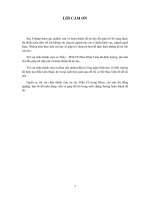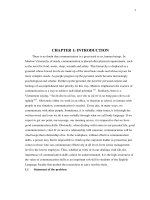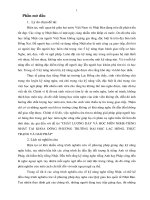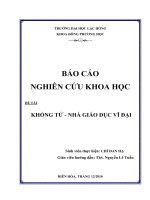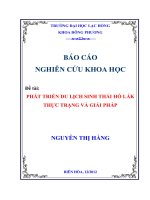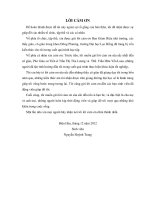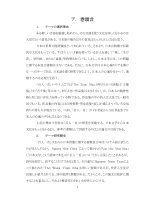Báo cáo nghiên cứu khoa học " CITRUS GREENING DISEASE (HUANGLONGBING) " pdf
Bạn đang xem bản rút gọn của tài liệu. Xem và tải ngay bản đầy đủ của tài liệu tại đây (16.27 MB, 43 trang )
CITRUS GREENING DISEASE
(HUANGLONGBING)
NGUYEN VAN HOA
SOUTHERN FRUIT RES. INSTITUTE
Assumptions in 2002: Huanglongbing and Diaphorina citri
evolved in south Asia — in the region that includes
Afghanistan, Pakistan and northwest India — but the disease
was possibly first noticed in southeast coastal China
Eastward spread of the
disease and vector to East
and Southeast Asia occurred
over the past 100 to 200
years — mostly through
human activities
This spread is continuing
through Indonesia towards
Australia and Oceania
Graphic maps:
Westward spread ‘occurred’
to Arabia and Réunion
Speculation & Developments in 2004:
Citrus evolved 60 million years ago in eastern Gondwanan
regions that now form parts of the Arabian Peninsula, India and
Australasia. The original host of huanglongbing is or was
asymptomatic
Graphic maps:
Huanglongbing and
Diaphorina citri evolved
in to the north west of
where these regions
The original host of
huanglongbing is or was
asymptomatic
Glycosmis and Oxanthera are
species of Citrus
2002: Diaphorina citri
occured in South America
(since the 1940s) and in
North America (since 1998
in Florida) – but
huanglongbing had not been
recorded in either region
2003/04: Huanglongbing,
possibly Liberibacter
asiaticus, found in Brazil
Graphic maps:
Cultivated region Area
(ha)
Varieties
Mekong river delta 34.000
Sweet orange, King mandarin, Nam roi pumelo, Tieu
mandarin, Tau Lemon, Tac.
DongNai river delta 400 TanTrieu pumelo
Hương Thuy - HuongTra- Hue 300 Thanh Tra pumelo
Huong Son- HaTinh & Tuyen Hoa 2500 PhuTrach pumelo, Bu orange
Ham Yen - Bac Giang (Tuyen Quang) Ha Giang 500 Sweet orange and Mandarin
Yen Binh, Doan Hung - YenSon 600 Doan Hung pumelo
Planning and Statistics Inst., 1994
Main regions for some special citrus fruit varieties in Vietnam
Area (ha) Production (Ton) Yield (ton/ha)
1995 1998 % 1995 1998 % 1995
1998 %
Whole
country
55589 67465 121.36
362349
378957
104.58 6.51 5.61 86.17
The North
14308 37985 265.48
57404 80428 140.10 4.01 2.12 52.89
The South
41299 43984 106.28
306491
298636
97.46 7.42 6.87 91.50
Northeast
4824 10105 209.47
147147
34282 232.46 3.05 3.39 112.62
Central-
North
6148 7743 125.94
23243 22661 97.49 3.78 2.92 77.24
Southeast
263 1485 564.63
3984 6310 158.38 15.14
4.24 28.00
Mekong
Delta
40579 41267 101.69
301308
286636
95.13 7.42 6.94 93.53
(Courtesy by Ha Minh Trung, 2001)
Table 1: Citrus production in Vietnam in 1995 and 1998
Since late 1994, after the survey by Dr. Aubert (Cirad –
Flhor) on Nov. 1994 and by Prof. Bove and Dr. Garnier (INRA)(
Feb, 1995), the Greening disease was detected and the causal
organism was identified as a gram negative bacterium (Candidatus
Liberibacter asiaticus).
In fact, the disease has occurred since early of 1960’s and
the incidence was from 1 to 5%. During this time, the technique
for fast multiplication was grafting. With this technique, every
year, they supplied 1 million of non free-disease seedlings to the
farmers in the region, which lead to 50-60% incidence of orchard’s
infection (Vu Khac Nhuong, 1997).
After 1975, in the North of Vietnam, the incidence of the
disease was around 60-100%. Of them, 30-40% citrus orchards
have not beard any fruit.
12.00013.51313.78114.68016.85216.526Area
(ha)
200019991998199719961995Year
Table 2: Citrus cultivated area at Cantho province
(1995 to 2000)
Average reduction of the citrus area per year is 1,000-2,000 ha
Citrus cultivated area (ha)
Year
Cultivar
1992 1995 1998
Orange
3,192 3,959 2,345
Mandarin
1,756 1,952 1,279
Pumelo
423 577 1,600
Table 3: Citrus cultivated area at Vinhlong province (1992 to 1998)
Hong, 2000 reported that bacteria made the trees lack of mineral
nutrients, such as reducing 70% of Zine in comparison with
healthy one, Calcium reduced 29%.
The loss due to this disease has not been calculated properly,
however, the approximately analysis showed that, at Cantho
(main province for citrus), the lost come upto 15 tons/ha on
sweet orange, 13 tons/ha on King mandarin and 9 tons/ha on
Duong mandarin (Chau et al, 2001).
It cause a lot of
damage to citrus
industry, due to
systemic infection
and made damage to
phloem tissues of the
tree, interfere the
nutrient flow which
lead to nutrients’
deficiencies in leaf,
fruit, root system,
etc. and finally the
tree no more bearing
and die.
19,43
26,99
16,45
25,78
29,02
19,12
0
20
40
60
80
100
120
Grade 5 + Grade 3+
Sweet oranget
King maandarin
Duong mandarin
Yield (%)
Yield lost (%)
Disease severity
Percentage of fruit yield lost due to HLB in Cantho (%)
Courtesy by Chau & Hong, 2003
In 1995, one survey in Vinhlong province was conducted by SOFRI
and Vinhlong provincial staffs.
Out of 300 orchards under the investigation, 288 orchards got
infection (96% infection).
18,4% orchards got more than 50% trees infection,
64,8% orchards got from 5 to 50% trees infection,
13,4% orchards got from 1 to 5% trees infection and
only 3,3% orchards showed symptomless.
In 1996, another survey on King mandarin at Tambinh district,
Vinhlong province at different ages showed that at:
4-5 years old trees: 80% tree infection (In 409ha survey)
5-8 years old trees: 20 -50% tree infection (In 276 ha survey)
8 years old trees: 1-5% tree infection (In 49 ha survey)
Motling symptoms on citrus leaves due to Greening
disease
Healthy leaf
Mottling symptoms on citrus leaves
Leaf becomes yellow, small in size, upright growth, vein
corking and like zine difficiency
Mottling symptoms
Hanh: Citrus microcarpa
Citrus maxima
Corky vein
Pumelo: Citrus
grandis (L.)
Mexican lime
Citrus aurantifolia
Sweet orange (Citrus sinensis)
Citrus reticulata Blanco
Citrus grandis (L.)
Aborted seed in fruits from
CG-BLO affected trees
adaxial surface
abaxial surface
Symptoms of HLB
Healthy
HLB
Hypersensitive
Reactions in Tobacco
HR induced by an extract
from infected leaves
No HR was induced by
extracts from healthy
leaves
Symptoms of HLB
In phloem tissues
BLO
2 µm
Candidatus Liberibacter
asiaticus
Spylla: Diaphorina citri –
vector transmitted bacteria
causing Huanglongbing
disease
NMC for DNA
hybridization
Grind and hybridize
Detection of greening bacterium in
psyllid vector using 2.6 kb probe
Detection of Greening disease using from
samples collected from different locations,
using probe 2.6 kb for DNA-DNA hybridization
Detection of viruses, viroids and bacteria by
DNA-DNA hybridization
